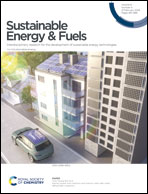Nanoarchitectonics of 3D-networked bio-based binders for silicon anodes in lithium-ion batteries based on dynamic hydrogen bonding†
Abstract
Silicon shows has high gravimetric capacity that is applicable in high-energy lithium-ion batteries. However, its poor cycling performance caused by severe volume expansion can prevent the development of silicon-based batteries. We present a new strategy based on an adhesive and flexible three-dimensional network to solve this expansion issue. Our strategy is to prevent ruptures of silicon anodes during charging by utilizing a renewable biomass konjac glucomannan (KGM) binder. The latter can form robust networks readily, and thereby efficiently alleviate the internal stress generated by the expansion of silicon anodes. Moreover, polydopamine with numerous phenol groups were interwoven in KGM networks to generate a strong adhesive force between it and silicon particles. The optimized electrode showed a high specific capacity of 3600 mA h g−1 and initial coulombic efficiency of 84%. Moreover, the capacity was >1030 mA h g−1 after 80 cycles, which was significantly greater than that of the PVDF anode (48 mA h g−1).



 Please wait while we load your content...
Please wait while we load your content...